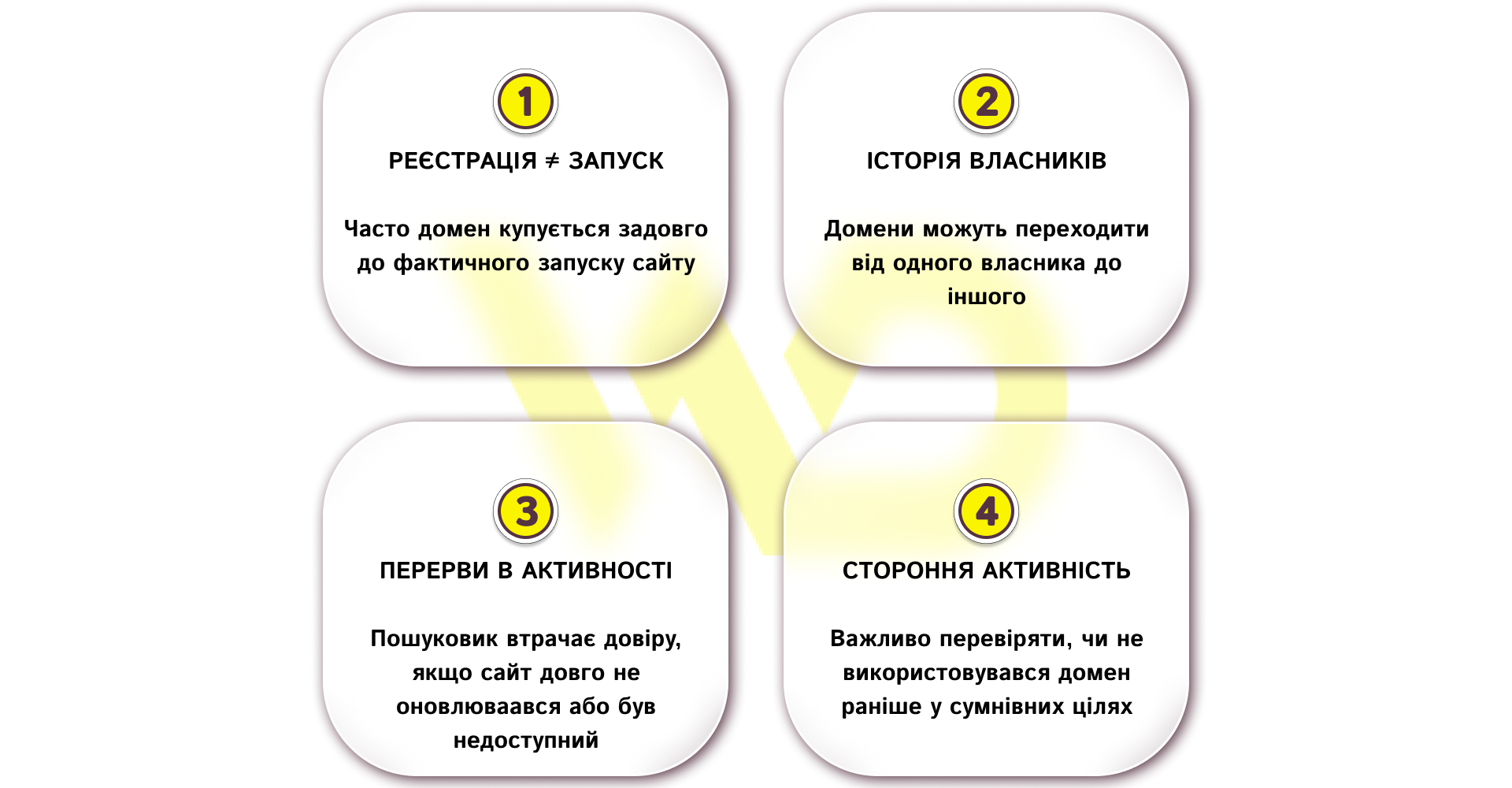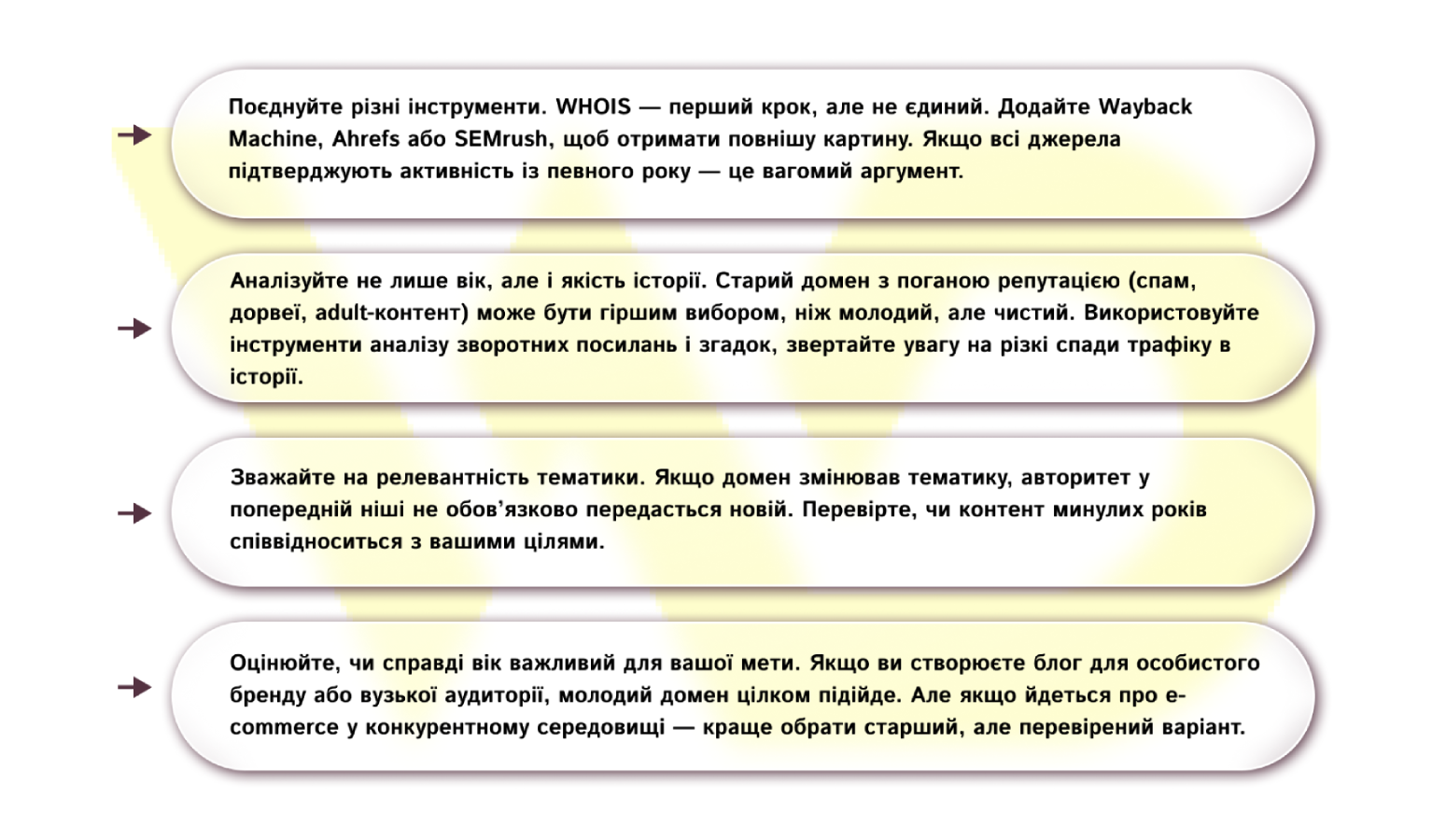Content of the article


Knowing the age of your domain is important. This is one of the signals for search engines that affects the credibility of a website, its reputation, and the perception of users and partners. In the business environment, this indicator is often seen as an indicator of stability: the older the domain, the more likely it is that the project is alive, reputable, and growing. In this article, we will look at how to quickly and accurately determine the age of any domain, what tools to use, and what to consider when analyzing it.
What is domain age and how it affects a website
Domain age is the period of time since its first registration. This does not always mean that the website has been working since that time. Sometimes a domain is purchased long before the site is launched or remains inactive for some time.
From the SEO point of view, an old domain can have the following advantages
- more chances to have natural backlinks;
- a history of indexing and trust with search engines;
- lower risk of being caught by filters (provided that the history is clean).
However, search engines, including Google, emphasize that age alone is not a determining factor in ranking. More important are the quality of content, external links, behavioral factors, etc.
Domain age is just one factor.
For a website to truly grow in search engine rankings, a comprehensive SEO strategy is required: technical optimization, content, link building. Entrust this to the WEDEX team, and we will help your website rise above the competition.
Myths and reality about domain age

The main ways to check domain age
There are several effective ways to find out when a domain was registered or when it started being used as an active website. In most cases, it is enough to combine several methods to make sure that the information is reliable and understand the real age of the resource on the Internet.
Checking through WHOIS services
WHOIS is an open protocol that allows you to get technical information about a domain: registration date, registrar, expiration date, etc.
Popular services for checking:
- whois.domaintools.com is one of the most comprehensive WHOIS tools: it shows current records and archived records (Historical WHOIS Data), allows you to track changes of owners and DNS records by year. It has an API for automation and paid plans with advanced analytics;
- ICANN WHOIS is the official registrar of the Internet Corporation for Assigned Names and Numbers. It guarantees the relevance of basic data: the date of creation and expiration, registrar. Free, but without history archiving;
- who.is is a fast and convenient web interface with cached results: registration date, expiration date, IP address, name servers. There are tabs with the history of changes and basic website availability statistics. Suitable for quick one-time checks.
How to use:
- Go to the service website;
- Enter the domain in the search bar;
- Pay attention to the Creation Date field – this is the date of initial registration.
For example: for example.com, the WHOIS result will show the Creation Date: 1995-08-14, which means that the domain is more than 25 years old.
Using the Wayback Machine service
The Wayback Machine allows you to see when exactly the site started functioning in its visual form, what content it had, and how it has changed over the years. This can be extremely useful if you are interested not only in the date of domain registration but also in the actual activity on it. For example, you can see if the site was public from the very beginning, or if the domain was idle for some time or used for technical needs.
How to check:
- Go to web.archive.org;
- Enter the domain;
- View the oldest recorded versions of the page.
The advantage of this approach is the ability to look back in time and estimate when the site actually went live, not just when the domain was registered. This helps to find out the true age of the project, which is important both from the point of view of SEO and for building trust in the eyes of users.
However, there are limitations. If the site has never been indexed or has been completely closed to bots, the archive will not be able to provide any information. It should also be remembered that a domain can be used without a website – for example, for mail, redirects, or technical needs. In such cases, the Wayback Machine will not record any pages, even if the domain has been around for a long time.
SEO tools (Ahrefs, SEMrush, Serpstat)
Professional SEO analysis platforms offer not only WHOIS data or Wayback Machine snapshots, but also a deep understanding of the domain’s history through behavioral and external metrics. They can help you track when a website first appeared in search results, how its visibility has evolved, and which external links have contributed to the growth of its authority.
What you can see and how to interpret it:
- Backlink history.
Ahrefs records the very first backlinks, which allows you to understand when the site started receiving external traffic. A sharp surge in new links may indicate the beginning of active promotion or the launch of a full-fledged resource.
- Organic traffic dynamics.
SEMrush and Serpstat display estimated data on the number of keywords in the top 10 and the approximate volume of visits. The steady growth of indicators after a certain date helps to determine when the site has really been working in the niche.
- First appearances in the index.
SERP analysis reports show when a domain first appeared in the organic search results. This indicator is often first recorded along with the first important content update or optimization work.
For example, in Ahrefs, you can look at the Backlink Profile History report and see that the first external links to example.com appeared in September 2018, although WHOIS showed the registration date of 2015. So, the real start of the site’s active life took place only three years after registration.
Using these tools in conjunction with WHOIS and web archives allows you to get a complete picture: from the technical age to the actual activity and SEO effectiveness of the site.
Other additional methods
In addition to the main services, it is worth paying attention to less obvious but informative sources. For example, some hosting providers store data about the first launch of the site on their servers, and you can find the relevant information in your personal account.
Another tool is the cache of search engines like Google or Bing, which can be viewed using the cache: operator. It shows the last recorded version of the page, which allows you to draw conclusions about the recent activity of the site.
In addition, mention monitoring services, such as Google Alerts or Mention, can help you find the first appearances of a domain in the index or mentions in the content of other resources. Although these methods are less accurate, when combined with other sources, they allow you to get a more objective picture of the real age and history of a domain.
It should be emphasized that these are optional «deeper» checks and are not as fast as the main methods.
What to consider when analyzing domain age
After determining the age of a domain, it is important not to limit yourself to the date of registration. In practice, this indicator can be misleading without context. To draw reasonable conclusions, you should consider a number of additional factors that will help you assess the real value of a domain for SEO or business purposes.

- Registration ≠ launch. Often, a domain is purchased long before the actual launch of a website. For example, a company may register a domain in 2013 but launch a website only in 2020. In this case, WHOIS data alone does not reflect the real history of activity. This can be clarified through the Wayback Machine or by analyzing the first mentions in search.
- History of owners. Domains can be transferred from one owner to another. For example, a medical website in 2018 may be bought out in 2022 for an online store. In such cases, Google may re-evaluate the site, and the previous results will not be relevant to the new topic.
- Breaks in activity. If a website hasn’t been updated or was inaccessible for a long time, search engines may lose trust in it. The domain seems to be «forgotten». For example, a website that worked in 2014-2016 and was then inaccessible until 2023 is considered a new project from the SEO point of view.
- Third-party activity. It is important to check whether the domain was previously used for dubious purposes. Such practices can leave a negative mark on the index and reputation. In Ahrefs or SEMrush, you can see an abnormal number of backlinks from irrelevant sources, a sharp drop in traffic, or mentions from undesirable sites.
These nuances help to form a complete picture of what is behind the registration date. After all, two domains created in the same year may have completely different actual ages and SEO impact, depending on their activity, reputation, and topic of use.
When domain age plays a crucial role
In most cases, the age of a domain is an additional factor, but in some situations, it can be crucial for the success of a project. Here are some examples when you should pay special attention to it:
Buying a domain second-hand
If you buy a domain at an auction or from the previous owner, its age can be an asset – provided that the domain has a clean history. Older domains often have a stable backlink profile, media or blog mentions, and may have residual organic traffic. However, before buying, be sure to check whether the domain has been used for spam or dangerous content.
Working in competitive niches
For example, in the financial, medical, or legal fields, trust and authority are of particular importance. Here, a young domain can take a long time to get into the search results, while old domains with a relevant history will have an advantage, all other things being equal.
Creation of PBN or satellites
When building private blog networks (PBN), old domains with a high-quality link profile are used, as this allows you to transfer weight to the main site. However, it is important to keep in mind the risks of such strategies – search engines are actively fighting against manipulative link building.
Launching a new project with a focus on rapid growth
In some cases, companies buy old domains with a suitable theme to avoid starting from scratch. For example, a marketing agency can find an old SEO blog, update the content, and in a few months have a good starting position in the search results.
Public procurement and tenders
In many countries, to participate in government tenders, you are checked not only for the presence of a website, but also for its history. An old domain with a solid background works as an indirect guarantee of your stability and experience, which increases the chances of winning a contract.
Mergers and acquisitions (M&A)
When buying or merging companies, auditors evaluate assets, including web infrastructure. The age of the domain is taken into account as part of the value of intellectual property – the longer the history, the higher the value of the asset recorded in the company’s accounting.
Brand protection and prevention of cybersquatting
Companies often register related domains not only for promotion, but also to prevent competitors or malicious actors from obtaining similarly named domains that are profitable. Old domains with similar names are valuable in marketing and legal brand protection strategies.
Restructuring or rebranding
If you are planning to switch to a new brand, an existing old domain with a good history can be used as a 301 redirect, giving it some of the old weight. It is important to understand the age and trust of the primary domain to make the solution effective.
Competitor analytics and niche purchases
Sometimes it is more profitable to buy an old but undervalued domain in the same topic than to create a new one. For niches with a narrow audience and low competition, «settling in» on someone else’s background and brand mentality can have an instant effect.
Archived projects and content
Sometimes web developers or editors of thematic blogs buy old domains to restore or «revive» previous content (for example, instructions, guides, research). Here, the age of the domain allows you to keep in touch with the audience that remembers the site from previous years.
Each of these cases shows that domain aging is an SEO factor and a tool for business strategies, legal protection, and marketing tactics that should be taken into account depending on specific goals.
How domain age affects building trust in the eyes of users
In addition to its technical and SEO value, domain age can play a significant role in shaping the first impression of website visitors. This is especially true for companies that operate in industries that require a high level of trust, such as finance, healthcare, legal services, or education.
When a user sees that a domain has been in existence for many years, it creates an impression of stability, experience, and reliability. For example, when checking a company in a search engine, a potential client may pay attention to the date of the resource’s foundation, media mentions, and a long history of content, and this will be an additional factor in favor of choosing this particular brand.
It’s worth noting that these psychological effects are especially influential in the B2B segment or when making decisions involving large expenditures. For example, when choosing a CRM platform or legal support, a client will be more likely to turn to a resource whose domain has been around for more than 10 years than to a newly created website with an empty blog. In this context, the age of a domain becomes an indirect tool for building a reputation, along with design, case studies, reviews, and content activity.
Practical tips
To correctly assess the age of a domain and its significance in your situation, act comprehensively. Keep the following recommendations in mind:

A correct analysis of the domain age will help you make an informed decision: save time on promotion, avoid SEO problems, and build a stable online presence from the first months of operation.






 25/09/2025
25/09/2025  1106
1106



